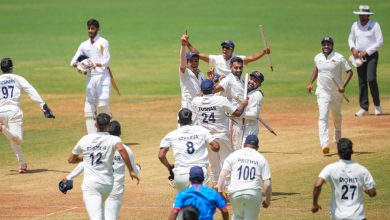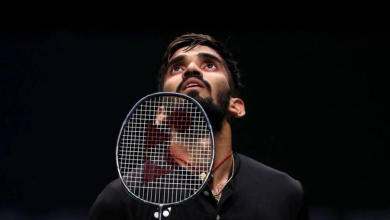David Warner: The Last Aussie standing

In some ways, David Warner seems to be the last Aussie standing. The stereotypical version of an Aussie batsman’s technique, for some of us from an earlier generation. Lot more arms, a sense of compactness, preference for punchy shots, boxer’s rapid foot movement in stance to the pacers, the horizontal strokes, the on-the-up salvos, and the sudden deceleration to soft-handed tip-and-runs. Above all, the arms in the shot production.
In those aspects, Warner is the last Aussie left. Techniques worldwide are coalescing so much these days that the hitherto uniqueness is fading out gradually. Warner is still a throwback, though.
The world cricket nearly didn’t have him. When he was 13, Warner was told his coach to switch to right-hand as he was hitting the ball too much in the air but a season later, with the backing of his mother Lorraine, Warner made the crucial decision to revert; who knows what’s to say what would have happened if he hadn’t.
This is intended to be a piece about his batting; his off-field issues have been well-documented, but just one episode is worth reiterating. Long before the ball tampering or the Joe Root punch, there was an episode at Brisbane’s Centre of Excellence when he was thrown out for attitude issues. This time around, his brother came to his help with an ultimatum. “I’m a plumber, and I said to him, ‘You can give it away and come labour for me, digging trenches, or you can put your head down and put everything into this if you want to be a professional sportsman’,” Steve, his brother, has said in the past. Luckily, Warner did.
The last Aussie standing is a bit of exaggeration of course; not in the terms of the final sample left but even in the lineage there have been Aussie batsmen who have differed from the norm. A Mark Waugh, or going back into the ms of time, Victor Trumper, if one is to believe the raves of the past. But it’s the norm that one is interested.
Consider the quintessential on-the-up punch. Until Sachin Tendulkar came along, it wasn’t natural in the Indian way. Not that no one played it; of course they did. Even Ravi Shastri, usually not associated with that shot, has unfurled a few such beauties (watch his 187 against England in 1990). The point, as ever, is the norm; what seemed natural. With Tendulkar it was. Up on his toes, a slight shift of weight to the back, and punching good back of length balls, and at times even length deliveries, back past the bowler. It used to be a startling sight in his initial days.
In the decade before Tendulkar, it was the Aussies who would play it easily, naturally, smoothly. Of course it was all that because they grew up on tracks with bounce. The arms power that shot. The Indians tend to collapse the arms a bit, and allow the wrs to enter the scene. Aussies jabbed like boxers. Warner does it. With him, perhaps since he is a left-hander, he punches more through covers. A young Warner was a lot more fiesty, pouncing on even length balls, if he was confident enough that there was no great deviation off the pitch, to punch em.
Warner doesn’t move his feet all that much but nearly every ball, even in defense or leaving the ball alone, there is a sense of furious kinetic energy at the crease. A side-on angle is best to view him. A furious press-back, then the opening of the front foot – he might just be defending the ball but until that moment of anaesthetising, he would make it seem as if he was about to jab.
It’s something he has worked on. During Mickey Arthur’s reign as coach, the focus apparently was on Warner getting his defence tighter – not a bad thing but it stripped him off the furious base he needs. It ended up anaesthetising himself somewhat, going the quote of the coach Trent Woodhill that he worked with during that phase. Alarmed at seeing him fail, Woodhill arranged a meeting to effect a turnaround- and would later say this to the Guardian. Terming Arthur was well-intentioned but the side-effect was detrimental to Warner.
His first thought “was to get his defence in order and get into his innings then look to attack. To me, that defeats his natural instincts and his natural instinct is to attack and when he looks to attack, he’s in a really good defensive position because he lets balls go late, he can play late, so he plays the swinging ball later, he moves his feet. I’m not saying he’s a big mover of his feet, but he moves his body well. And when you look to defend, you naturally become really stable and stable isn’t such a good thing if it means you can’t move and react.”
It’s interesting that Woodhill says that as it also sides with the stereotypical Aussie batting image that resides in the head. That busyness. Consider the frenetic movements of Michael Slater, a fabulous Test opener from Australia. Seldom has anyone taken the back-and-across movement to heart as much as he did. Very busy; yet, so compact. So Australian.
Australia’s David Warner celebrates after scoring a century during the second cricket test between South Africa and Australia at the Melbourne Cricket Ground, Australia, Tuesday, Dec. 27, 2022. (AP Photo/Asanka Brendon Ratnayake)
Steve Waugh, to an extent, had that. Pressing back and across, on the move, trying to gain as much time as possible to defend. Slater would use that extra time to attack; Waugh for defense. Of course, then suddenly, he would flash his arms for that spanking cut. Not the horizontal shot necessarily, but a flamboyant fluid release of punchy arms. Ian Chappell too swore that back-and-across movement. David Boon had a furious twirl of the bat and a fierce cut,
For the flamboyance in horizontal shots, Gilchr was a good example. But he would push on where the other Aussies, traditionally, stopped. With him the extension of the arms was the thing. Where most batsmen stop their arm-swing, Gilchr’s arms would go cleanly through the line of the ball. You can only marvel at the absence of any self-doubt that allows him to play like that.What if the ball cuts away fractionally? What if it keeps slightly low or higher than what one expected? What if the length is fractionally shorter or fuller than what one thought? What if the pace is slower than anticipated? It’s as if he had no such doubts. Through his career he did the improbable – made happy both the purs and those who seek instant gratification.
Warner doesn’t let go of himself that way in all his shots. He curtails his punch; else it’s not a punch definition. At times, he would be airborne when he plays that on-the-up punch.
Before his 100th Test, some of his team-mates were asked Channel 7 about what they think is Warner’s trademark shot. The swivel-lap-around pull-flick he plays was picked the likes of Josh Hazlewood; incidentally it was the shot with which he brought up his hundred; a four off Kagiso Rabada. Some like Marnus Labuschagne and Travis Head went for the square-drive. It’s a shot he has played a million times. The bowlers tend to take it across from the back of length or length and try to surprise him with the fuller one, hoping to catch him off-balance. But in his pomp, he would keep scything that ball through cover point. But we have seen the prince of that shot, regardless of the length, in Brian Lara. So, it’s the punch that’s best associated with Warner. It suits his fey personality and the overall balance he strives to keep at crease.
For a long while, he would be so intent on staying side-on, that compactness allows him that balance to unreel all the off-side devilry, that the bowlers could tie him up on the leg and middle line. They still do it, go around the stumps and nail him there. Then, he would press back, almost jump back, and try to shovel it behind square to change the strike. If the bowler misses the good length and drags it back, he can collapse the arm for his short-arm pulls. Stuart Broad did the angle best, taking the ball away marginally from Warner to induce edges.
Australia’s David Warner celebrates after scoring 200 runs during the second cricket test between South Africa and Australia at the Melbourne Cricket Ground, Australia, Tuesday, Dec. 27, 2022. (AP Photo/Asanka Brendon Ratnayake)
Failure against quality spin on turners?
That would remain an asterisk on his batting. He hasn’t quite settled that debate, it has been said. R Ashwin has upset his most prized element at the crease – his balance, his compactness- and has troubled him. If the pitch allows for the ball to turn the width of two stumps, then Ashwin would land it outside leg. Forced to open up, Warner couldn’t cope up without the silken wrs needed to smother it. He has tried jumping out; no luck. He has tried pressing back; no luck. Perhaps because of his short height and reach, his sweeps in the subcontinent don’t have that venom-stripping effect of Matthew Hayden, who would come down hard on the ball from the top. Warner still tries to sweep bat parallel to the ground and without the necessary reach, he hasn’t always managed to get out of jail with that weapon on turners.
In his te, Labuschagne had first mentioned Warner’s imperious down-the-track lofted shots to spin. Presumably, he is talking about shots on tracks that didn’t help turn.
The lofted shot that still sticks in the mind is the one he played during a 2012 knock of 180 against India at Perth, incidentally the innings that his father once rated as his aggressive best.
The memory is still clear. For some reason, perhaps to grab a beer, one was walking the boundary line in the stands near long-on, with the head tilted towards the middle just in time to see a brutal sight. There was Warner leaning forward, sinking on his right knee, to absolutely murder a length ball from Vinay Kumar into the stands. Beer glasses flew up from the stands in appreciation and one exchanged glances with a fellow journal – ‘Vinay ka career toh giyyo’ was the whisper. Luckily, Vinay would mature on from that moment and lead Karnataka to great triumphs in domestic cricket and also do well in IPL. That shot was off his bowling, but that day Warner was smashing everyone.
When long careers wind up, more often than not, the fans tend to be large-hearted, remembering the good moments more. With Warner the batsman too, that can be expected more or less. The press-backs, the ability to go airborne and still maintain balance for punches, the deliberate letting-go of the arms to slash over slips, the swivel-pulls off hips. The compactness, the arms … the last Aussie, standing.







